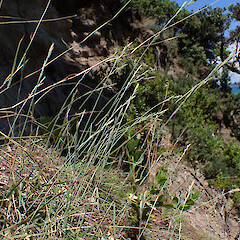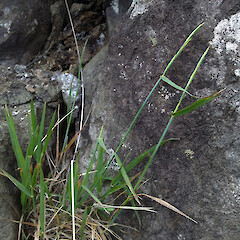Anthosachne kingiana subsp. multiflora
Common name
blue grass, blue wheat grass
Synonyms
Triticum multiflorum Hook.f., Agropyron multiflorum (Hook.f.) Cheeseman, A. kirkii Zotov, A. multiflorum var. longisetum Hack., A. kirkii var. longisetum (Hack.) Zotov, Elymus multiflorus var. longisetus (Hack.) Á.Löve et Connor; Elymus multiflorus (Hook.f.) Á.Löve et Connor subsp. multiflorus; Anthosachne multiflora (Hook.f.) C.Yen et J.L.Yang subsp. multiflora
Family
Poaceae
Flora category
Vascular – Native
Endemic taxon
No
Endemic genus
No
Endemic family
No
Structural class
Grasses
Chromosome number
2n = 42
Current conservation status
The conservation status of all known New Zealand vascular plant taxa at the rank of species and below were reassessed in 2017 using the New Zealand Threat Classification System (NZTCS) – more information about this can be found on the NZTCS website. This report includes a statistical summary and brief notes on changes since 2012 and replaces all previous NZTCS lists for vascular plants.
Please note, threat classifications are often suggested by authors when publications fall between NZTCS assessment periods – an interim threat classification status has not been assessed by the NZTCS panel.
- Conservation status of New Zealand indigenous vascular plants, 2017 . 2018. Peter J. de Lange, Jeremy R. Rolfe, John W. Barkla, Shannel P. Courtney, Paul D. Champion, Leon R. Perrie, Sarah M. Beadel, Kerry A. Ford, Ilse Breitwieser, Ines Schönberger, Rowan Hindmarsh-Walls, Peter B. Heenan and Kate Ladley. Department of Conservation. Source: NZTCS and licensed by DOC for reuse under the Creative Commons Attribution 4.0 International licence.
2017 | At Risk – Declining | Qualifiers: DP, SO
Previous conservation statuses
2012 | Data Deficient
2009 | Not Threatened
2004 | Not Threatened
Distribution
Indigenous. In New Zealand present from the Three Kings Islands south throughout the North Island to the South Island from Nelson to Banks Peninsula. Also present in Eastern Australia.
Habitat
Primarily a coastal species of cliff faces, and rocky ground, utilising rocks of various substrates but showing a decided preference for base-rich substrates such as limestone, calcareous mudstone, siltstone and sandstones, basalt or the zeolite-rich facies of greywacke. On offshore islands it occasionally grows on open clay pans.
Detailed description
Tufted, stoloniferous, glaucous to green grass. Leaf-sheath 6–10 mm, striate, glabrous or retrorsely short hairy. Ligule 0.2–0.5 mm, margin frayed. Leaf-blade 100–200 × 2–4 mm, flat bright green or glaucous, ribbed, underside with small antrorse teeth or glabrous, upper with antrorse short hairs or prickle-teeth on ribs, margin shortly prickle-toothed. Culm 300–600(–900) mm, erect, suberect or drooping. Inflorescence 100–250 mm, of up to 6–15 spikelets. Spikelets 14–25 mm, of 7–12 florets. Glumes ± equal, 5–9 mm, 3–5-nerved, keeled, broad, margins papery, ciliate; keel and nerves prickle-toothed, sometimes extending into a short awn. Lemma apex often bifid, awn absent or about length of lemma. Palea 9–12 mm, apex truncate, retuse, ciliate. Rachilla 1–2.5 mm, hairy. Callus 0.75–1 mm, with scattered short hairs. Anthers 3–5 mm, purple or yellow.
Manaaki Whenua Online Interactive Key
Similar taxa
Not closely allied to any of the endemic New Zealand species and unlikely to be confused with any of them. Long-awned forms could be confused with short-awned variants of Anthosachne solandri, but the awns in that species are recurved never straight.
Flowering
September–February
Flower colours
Violet/Purple, Yellow
Fruiting
October–May
Life cycle
Florets are dispersed by wind and attachment (Thorsen et al., 2009).
Propagation technique
Easy from fresh seed and rooted pieces. Likes a sunny aspect in free draining soil. The long-awned froms are especially attractive.
Threats
North Island populations have declined a lot and now not commonly found unless in little pockets. Competition from weeds is a major issue.
Etymology
multiflora: From late Latin, feminine of multiflorus meaning ‘bearing many flowers’
Where To Buy
Occasionally offered by specialist native plant nurseries.
Attribution
Fact sheet srepared for NZPCN by P.J. de Lange June 2005. Description adapted from Edgar & Connor (2000).
References and further reading
Barkworth ME, Jacobs SWL. 2011: The Triticeae (Gramineae) in Australasia. Telopea 13: 37–56.
Edgar E, Connor HE. 2000. Flora of New Zealand. Vol. V. Grasses. Christchurch, Manaaki Whenua Press. 650 p.
Govaerts R. 2014. New combinations for Philip Island wheat grass, Anthosachne kingiana subsp. kingiana (Poaceae). Journal of the Adelaide Botanic Gardens 27: 23–24.
NZPCN Fact Sheet citation
Please cite as: de Lange, P.J. (Year at time of access): Anthosachne kingiana subsp. multiflora Fact Sheet (content continuously updated). New Zealand Plant Conservation Network. https://www.nzpcn.org.nz/flora/species/anthosachne-kingiana-subsp-multiflora/ (Date website was queried)










